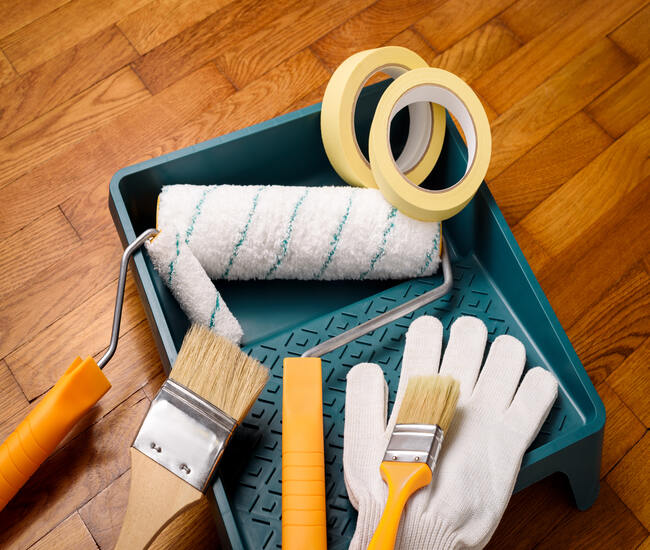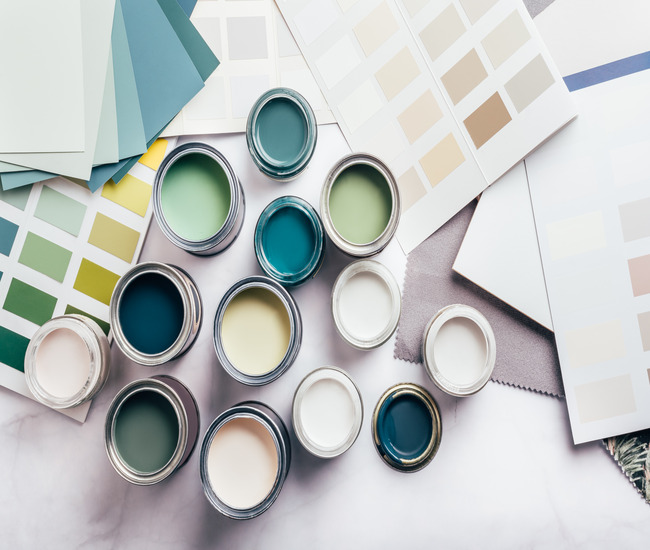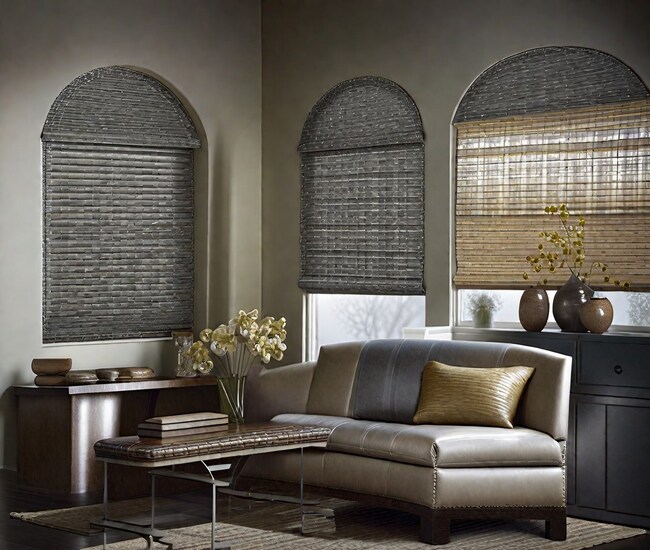Want to change the decor of your space by painting blinds from wood, bamboo to a finish you love? Bamboo shades always look great and you can easily customize their look to match the existing theme of your home.
These practical DIY tips to paint natural woven fiber blinds will make a huge difference.
Painting wooden window treatments is not a difficult job, even those without any genuine artistic talent or skill can do this in minutes.
There are various options for painting bamboo blinds and not all of them need a paintbrush.
The simplest way to work with bamboo blinds is to use spray paint. But, when painting, make sure you don’t touch the blind itself and work around from the sides.
White and darker brown are popular color choices.
What are Woven Wood Shades?

Also referred to as bamboo blinds, matchstick shades, or natural wood shades, woven wood shades are easy to use and affordable window coverings that come with lots of design possibilities.
They are made from bamboo, rattan, reeds, rattan, grasses, and jute, and add a “green” factor or rustic touch to your home decor. Some are made from thick sticks, while others consist of wider half sticks of bamboo.
Woven blinds are available in different styles, ranging from classic roll-up and fold-up designs to cordless and top-down, bottom-up styles.
Tools & Materials You’ll Need

- Paint
- Paintbrush or paint sprayer
- Stencil (if needed)
- Drop cloth
- Paint remover (if needed)
Choosing a Suitable Paint Color

- Select a paint color that caters to your taste, complements your room’s interior decor style, and works well with the woven texture of the shades.
- Select the appropriate paint and sealant designed for wooden surfaces.
- Choose a paint that is suitable for wooden surfaces and provides good coverage.
- Before you start applying it to your blinds, thoroughly stir the paint to ensure an even consistency.
Easy DIY Steps to Paint Your Woven Wood Shades
These painting tips can help you give a professional-like finish to your window coverings.
Step 1: Take the Shade Down
- Fully close your shades.
- Remove shades from the brackets.
Step 2: Prepare Them for Painting
- Choose a well-ventilated area, such as an outdoor space or a garage, to paint your natural wood shades.
- Select a flat surface and lay a large drop cloth on it to protect the surface from paint drips and spill.
- Roll out your woven wood shade on the top of the cloth with the side you want to paint should be facing you.
- Make sure you fully extend the shade and completely straight.
- Make it stable by weighing down each end.
Step 3: Thoroughly Clean the Shades
- Remove any dust, dirt, debris, or grime from the shades by gently vacuuming or using a soft brush attachment.
- Wipe them with a clean, damp cloth to remove any remaining grime or stains.
- Allow your bamboo blinds to dry completely before you proceed to the next step.
Step 4: Apply a Primer (Optional)
- To ensure better paint adhesion, consider applying a primer.
- You’ll also need to apply a primer if your shades have a dark or uneven color.
- Choose a primer that is suitable for both wooden surfaces and the type of paint you plan to use.
- Apply the primer evenly to your woven wood shades using a brush or a paint sprayer.
- Allow the primer on the blinds to dry completely before proceeding to the next step.
Step 5: Start Painting the Shades Now
Painting
- Use a paint sprayer or a brush to apply the paint to your window treatments.
- Make sure to work in small sections and evenly apply the paint in the direction of the weave.
- Pay attention to any crannies or nooks in the weave to ensure complete coverage.
- Allow the paint to dry as per the manufacturer’s instructions.
Step 6: Apply Additional Coats (If Needed)

- Depending on your desired color and coverage, you can apply multiple coats of paint to your natural wood shades.
- Make sure that each coat dries completely before you apply the next one.
- Check for any areas that need additional paint coverage or touch-ups.
Step 7: Paint Your Favorite Design
- Use freehand painting if you want to customize your wooden shades with a design.
- Choose your design and practice drawing it on a piece of paper.
- Paint designs on bamboo as you did on a piece of paper.
- If you make a mistake, wipe off the paint with the help of some paint remover.
Step 8: Use a Stencil to Produce Cut Designs
- Use a stencil if you aren’t comfortable with freehand painting.
- Use a paint brush or spray paint with the stencil.
- Tape paper around the edges of the stencil before laying it on the blind to prevent accidentally spraying or painting the blind.
- Once painting is done, gently lift off the stencil and allow the paint to dry.
Step 7: Seal the Painted Surface (Optional)
- If you want to protect the painted surface to enhance its durability, consider applying a clear varnish or sealant.
- If you go for a sealant, go for one that’s specifically designed for wood surfaces.
- Apply the sealant according to the manufacturer’s instructions, using a roller or a brush.
- Allow it to dry completely before reinstalling the woven wood shades.
Step 8: That’s All! Reinstall Your Shades
- Make sure the paint and sealant are fully dry.
- Carefully reinstall the bamboo blinds in their original location.
Note
- If you are a newbie, you should test the paint and sealant on a small, inconspicuous area of your shades before painting the entire surface.
- To achieve the best results, you should follow the manufacturer’s instructions for preparation, application, and drying times.
Why Should Your Bamboo Blinds be Painted?

Customizing Look: Woven wood blinds are usually available in natural or neutral colors. Painting will allow you to introduce vibrant colors that complement and boost your home’s overall color scheme.
Refreshing or Updating Look: Are your existing woven wood window covers worn out or outdated? Painting them will refresh their look and feel. You won’t need a complete replacement, saving you both time and money.
Concealing Stains: Over time, natural wood blinds may develop minor imperfections or stains. A layer of paint can conceal these blemishes and give your shades a cleaner and more polished look.
Protection and Durability: Painting bamboo blinds with suitable paint and sealant can provide an additional layer of protection against wear and tear. The paint shields the woven materials from potential damage, such as fading from sunlight or moisture absorption.
FAQs
Can you spray paint woven wood blinds?
The answer is yes! You can easily spray paint your woven wood blinds. It’s one of the easiest ways to change the color of your wooden blinds and give your room a new look.
Follow these DIY steps:
- Remove strings and fasteners that hold the strips together.
- Wipe clean the strips and let them dry.
- Evenly spray paint on each side of strips and let them dry.
- Fasten the strips and hang your wooden blinds back on the window.
Can you paint rattan shades?
Yes, you can! And luckily, painting rattan shades is an easy and effective way to restore their former glory quickly. Adding a fresh coat of paint to your rattan shades is a simple, straightforward DIY job, which can be easily done at home.
Can you paint wood blinds without taking them apart?
Yes, it is possible to paint wood blinds without taking them apart. However, the job becomes much trickier. Particularly, to reach the higher slats, you may need to climb all over the ladders or chairs, putting your safety at risk.
Still Unsure?
Need further help painting your woven wood shade? Contact our DIY experts for more practical tips and solutions. Use 24/7 live chat or give us a ring at (800) 863-6109 now.